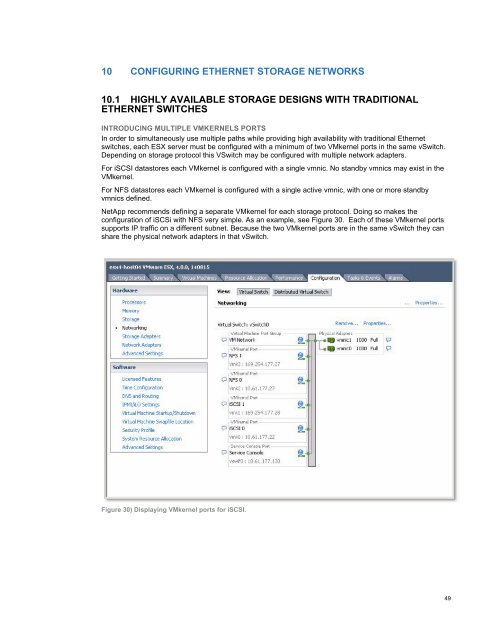NetApp and VMware vSphere Storage Best Practices
NetApp and VMware vSphere Storage Best Practices
NetApp and VMware vSphere Storage Best Practices
Create successful ePaper yourself
Turn your PDF publications into a flip-book with our unique Google optimized e-Paper software.
10 CONFIGURING ETHERNET STORAGE NETWORKS<br />
10.1 HIGHLY AVAILABLE STORAGE DESIGNS WITH TRADITIONAL<br />
ETHERNET SWITCHES<br />
INTRODUCING MULTIPLE VMKERNELS PORTS<br />
In order to simultaneously use multiple paths while providing high availability with traditional Ethernet<br />
switches, each ESX server must be configured with a minimum of two VMkernel ports in the same vSwitch.<br />
Depending on storage protocol this VSwitch may be configured with multiple network adapters.<br />
For iSCSI datastores each VMkernel is configured with a single vmnic. No st<strong>and</strong>by vmnics may exist in the<br />
VMkernel.<br />
For NFS datastores each VMkernel is configured with a single active vmnic, with one or more st<strong>and</strong>by<br />
vmnics defined.<br />
<strong>NetApp</strong> recommends defining a separate VMkernel for each storage protocol. Doing so makes the<br />
configuration of iSCSi with NFS very simple. As an example, see Figure 30. Each of these VMkernel ports<br />
supports IP traffic on a different subnet. Because the two VMkernel ports are in the same vSwitch they can<br />
share the physical network adapters in that vSwitch.<br />
Figure 30) Displaying VMkernel ports for iSCSI.<br />
49


